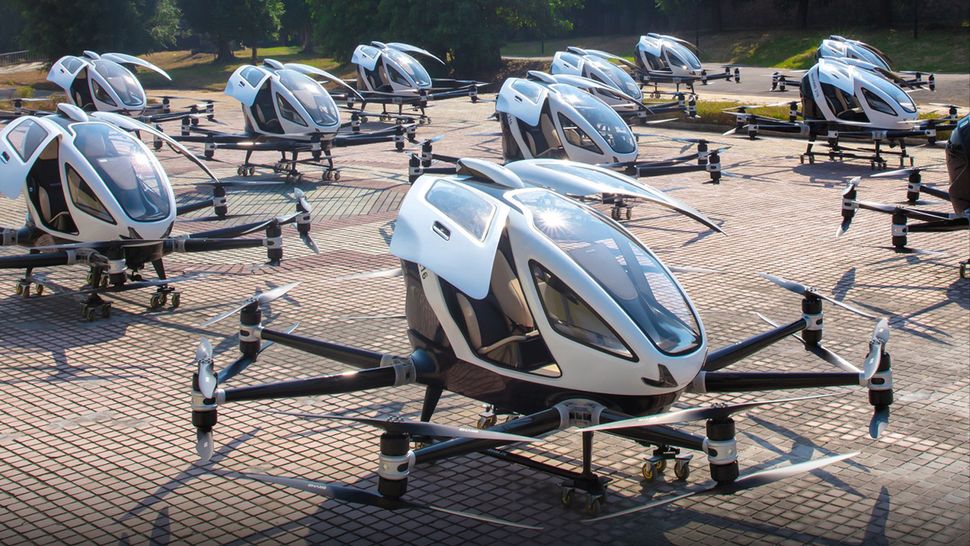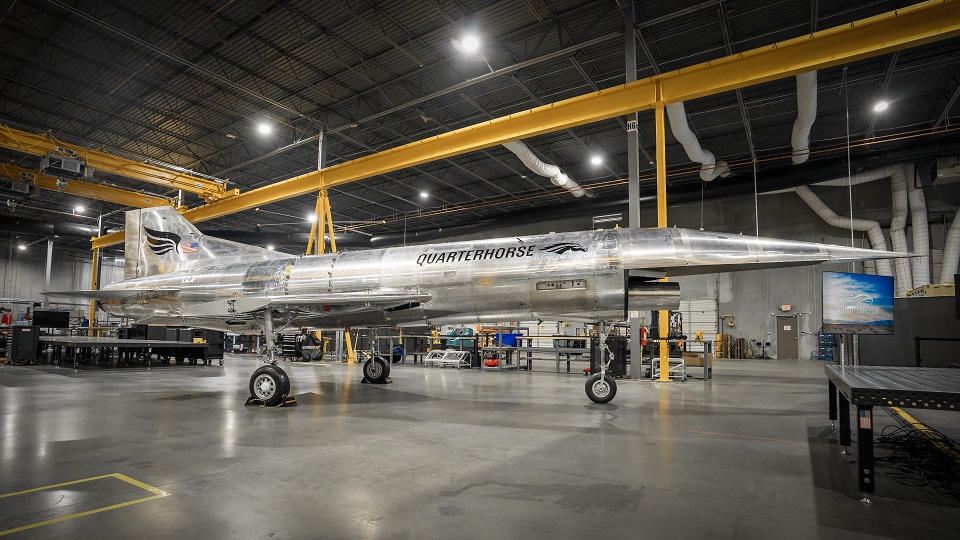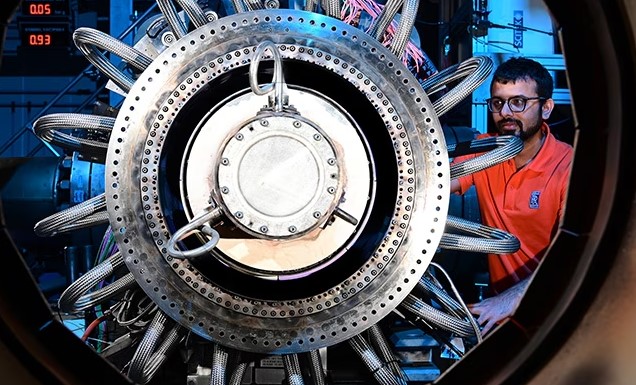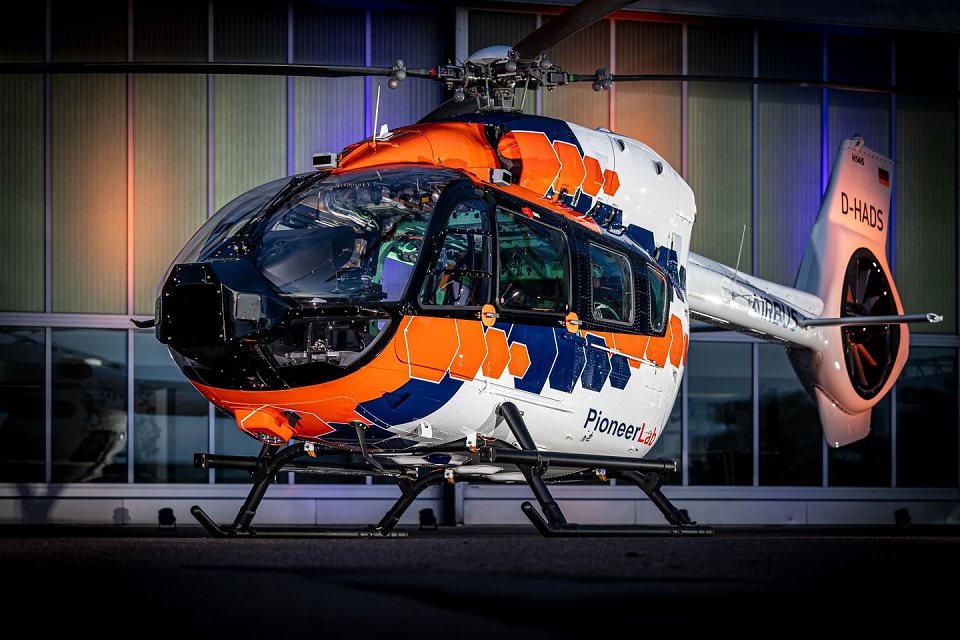Tech
What effects will the growing usage of drones have on the aviation sector?

The aviation sector is anticipated to be significantly impacted by the rising usage of drones in a number of ways. These are a few possible effects:
- Safety: There may be a higher chance of manned aircraft collisions as more drones take to the skies. This might result in new guidelines and standards for drone operators and pilots’ safety.
- Employment: The development of drones may result in fewer jobs for human pilots and others involved in the aviation industry. The drone business, however, may also result in the creation of new opportunities for engineers, designers, and operators of drones.
- Logistics and transportation: Particularly in isolated or difficult-to-reach places, drones have the potential to revolutionize the distribution of products and services. For businesses that specialise in logistics and transportation, this could result in new business prospects.
- Surveillance and monitoring: A wide variety of companies, including agriculture, construction, and environmental management, can use drones for surveillance and monitoring. This might result in new uses for drone technology as well as new collaborations between the makers of drones and other sectors of the economy.
- Airspace management: For the airspace to be used safely and effectively as drone traffic grows, more advanced airspace management technologies will be required.
Typically, the growing usage of drones is likely to bring about considerable changes in the aviation business, both good and bad. It will be crucial, as with any new technology, to responsibly and sustainably manage the risks and opportunities that drones provide.

Tech
China will produce flying taxi like Mobile phones in 2025

In a groundbreaking development poised to revolutionize urban transportation, EHang, a leading vehicle manufacturer, has secured the first-ever production certificate in China for self-flying taxis.
Dubbed the EH216-S, these cutting-edge vehicles mark a significant leap forward in autonomous air mobility, reshaping the landscape of urban travel. Announced by EHang representatives on April 7.
The Civil Aviation Administration of China (CAAC) has granted clearance for the mass production of EHang’s EH216-S, heralding a new era of commercial viability for electric vertical takeoff and landing (eVTOL) technology.
Unlike traditional taxis, these innovative vehicles operate without the need for a pilot, offering passengers a seamless and exhilarating travel experience. While numerous companies have explored the concept of eVTOLs, EHang’s milestone achievement distinguishes itself as the first tangible step towards realizing the commercialization of this transformative technology.
With the production certificate in hand, EHang is poised to initiate the mass production process, encompassing every aspect from sourcing raw materials to quality control, under rigorous scrutiny and oversight.
Huazhi Hu, CEO of EHang, articulated the company’s vision of ushering in a new era of safe and eco-friendly air mobility services on a global scale. With a steadfast commitment to safety and reliability, EHang aims to introduce autonomous eVTOL aircraft that redefine the concept of urban transportation, offering unparalleled convenience and efficiency to passengers worldwide.
The EH216-S stands as the epitome of EHang’s innovation, boasting a fully-electric design and the capacity to accommodate two passengers. With a cruising speed of 62mph, this state-of-the-art vehicle has undergone extensive testing, both with and without pilots, ensuring optimal performance and safety standards.
Aerospace
NASA’s Ambitious Plan to plant trees in moon

In a groundbreaking move, NASA is gearing up to embark on a mission unlike any before: planting trees on the moon. This ambitious endeavor marks a significant leap forward in lunar exploration and sustainability efforts.
With the aim of expanding understanding of extraterrestrial environments and potentially laying the groundwork for future colonization, this initiative captures the imagination and pushes the boundaries of space exploration.
The project, aptly named Lunar Effects on Agricultural Flora (LEAF), is slated for a September 2026 lunar landing. It represents NASA’s inaugural endeavor to grow vegetation in the harsh conditions of space, holding the promise of revolutionizing the way we envision sustaining future space missions.
At the heart of this endeavor lies a miniaturized lunar greenhouse, a testament to human ingenuity and technological advancement. The LEAF project aims to explore the feasibility of cultivating crops in space, a crucial step towards establishing sustainable habitats beyond Earth.
But why duckweed, cress, and brassica, you may wonder? These selected plants represent more than just foliage; they symbolize resilience and adaptability in the face of challenging environments. Through rigorous experimentation, scientists aim to unlock the secrets of plant growth in microgravity, paving the way for self-sustaining extraterrestrial ecosystems.
Space Lab Technologies leads the charge on this ambitious project, joined by esteemed partners such as the University of Adelaide, La Trobe University, and the United States Department of Agriculture, among others. Together, they form the Plants for Space (P4S) consortium, pooling expertise and resources to tackle the complexities of space agriculture.
“Importantly too, the technologies and practices developed as part of Plants for Space will improve life on Earth and benefit all Australians by addressing challenges like food security and water scarcity,” highlights a spokesperson for the project. Indeed, the implications of this research extend far beyond the confines of our celestial neighbor, offering solutions to pressing issues facing humanity on Earth.
Tech
Hermeus unveils new uncrewed aircraft Quarterhorse Mk 1

The Quarterhorse Mk 1 aircraft, which will launch later this year, has been unveiled by Hermeus, the company operationalizing hypersonic aircraft.
In under seven months, the business designed, constructed, and integrated this vehicle—Quadhorse Mk 0 finished its test campaign in November 2023—becoming its second fully-integrated vehicle in as many years. As a new benchmark for the rate of aircraft development, the team has set one aircraft every year for this rate of iteration.
Equipped with a GE J85 engine, the Quarterhorse Mk 1 is a remotely controlled, unmanned aircraft. As a critical enabling capability exclusive to future hypersonic aircraft on the company’s roadmap, its main goal is to demonstrate high-speed takeoff and landing. At Edwards Air Force Base, there will be flight testing.
With the completion of this milestone, Mk 1 moves from the “design and build” phase to the “integrated test” phase. In order to get ready for a flight test later this year, the vehicle will undergo a series of tests in the upcoming months covering its operations, human aspects, ground station, and subsystems.
In addition to showcasing the aircraft, Hermeus also shared plans for the next iteration of Quarterhorse – Mk 2 – which will feature the Pratt & Whitney F100 engine and fly at supersonic speeds next year.
The company’s roadmap to Darkhorse, a multi-mission hypersonic aircraft for defence and national security missions, is accelerated by Hermeus’ strategic decision to switch to the more capable F100 engine for Quarterhorse Mk 2. At the same time, the company delivers a compelling intermediate product—the only purpose-built high-Mach drone in the world.
Tech
World’s first flying car Takes Flight with Landmark Order

A historic agreement was reached between PAL-V and Dubai-based Aviterra to introduce the Liberty flying car to the Middle East and Africa.
Aviterra is investing, forming a partnership, and purchasing more than 100 PAL-V Liberty flying vehicles for the Middle East and Africa.
The PAL-V Liberty, which combines a gyroplane and a car, is referred to as the first actual flying automobile in history. It improves travel flexibility and travel independence by eliminating the need for (congested) roadways. The Liberty reduces travel and commuting times with its 500 km flight range and 180 km/h top speed.
“We’ve always kept a close eye on the emerging Advanced Air Mobility industry while running a business aviation company,” Wadaa says, emphasising the special possibility that PAL-V offers. “Our customers can safely FlyDrive using the current air and road infrastructure due to PAL-V’s long-standing presence and adherence to existing regulations.”
Moreover, PAL-V is the only player that has a vehicle that mixes driving and flying. This combination is unmatched by any other competitor in the industry, and they can actually produce the cars soon.” Aviterra’s investment division, Loggia Investment, has formed a partnership for the Middle East and Africa and made a strategic investment in PAL-V.
PAL-V is expanding its flying car business by establishing regional offices globally. PAL-V’s sales, maintenance, flight training, and assembly locations are centralised at these regional offices.
Aerospace
Lufthansa and BBJ Set New Standards with VVIP Cabin Concept at Dubai Airshow

Lufthansa Technik AG and Boeing Business Jets (BBJ) have released the complete specifications of their latest VVIP cabin concept for the BBJ 777-9 in advance of the Dubai Airshow, which takes place starting next week.
With an overall surface area of nearly 340 square meters, the interior’s new renderings showcase a design that is especially suited to the needs of a new generation of head-of-state and VVIP aircraft. The finished designs incorporate classic elements from the Middle East’s rich cultural legacy with a contemporary twist, and they have finally revealed the new concept’s name.
Lufthansa Tech Designs VVIP cabin concept for the BBJ 777-9
The new cabin design’s standout feature is the cocoon-like Private Bed- and Bathroom, which, along with the adjacent Work&Balance space, create the VVIPs’ multipurpose Private Suite.

If the VVIP passengers want to enjoy the largest rain and massage shower ever designed for a private jet or make themselves at home in the generous king-size bed, the bathroom and sleeping quarters can merge into a self-contained retreat offering the greatest possible privacy.
Particularly eye-catching are the large window shades with electrochromatic dimming, which are fully integrated into the oriental-inspired design of CelestialSTAR. With their three-dimensional structure and the targeted use of indirect lighting, they continue the design principle of the side walls in a functional way, thus delivering a generous spatial impression all-around, even when closed and without daylight.

Business
Next summer, Etihad will travel to Safari with direct flights to Nairobi.

Starting May 1, 2024, Etihad Airways will be offering daily flights from Abu Dhabi to the lively capital of Kenya. This route not only provides travelers with the chance to explore the vibrant city of Nairobi but also serves as a gateway to the adventures of a Kenyan safari.
ABU DHABI, UAE – Etihad Airways is excited to announce the resumption of flights to East Africa, with daily flights to Nairobi scheduled to commence on May 1, 2024. This new route will connect Kenya’s capital to Etihad’s expanding global network and play a pivotal role in strengthening cultural and economic ties between the UAE and this East African powerhouse.
“We are thrilled to reintroduce flights to Nairobi, a city brimming with dynamism and excitement, and a gateway to the dream adventure of a Kenyan safari, which entices many travelers with its diverse and magnificent African wildlife,” expressed Antonoaldo Neves, Chief Executive Officer of Etihad Airways. “Moreover, we look forward to extending a warm welcome to our Kenyan guests in our extraordinary home while offering them access to our ever-growing global network.”
These flights will reestablish commercial non-stop passenger connections between the two cities, and passengers from Kenya will have the opportunity to seamlessly connect with Etihad flights to the GCC, the United States, Europe, India, and South-East Asia.
The new route is poised to boost cross-business and trade prospects between the UAE and the burgeoning Kenyan economy.
Nairobi boasts a vibrant cultural scene and serves as a hub for modern African music. Additionally, the city is a launching point for experiencing Kenya’s iconic safari destinations, including the world-renowned Masai Mara National Reserve, where fortunate visitors can witness ‘the big five’ – African elephants, rhinoceros, Cape buffalo, leopards, and, of course, lions.
For East African travelers, this new Nairobi route offers exciting opportunities to explore Abu Dhabi’s cultural treasures and relish its renowned hospitality. From the awe-inspiring Sheikh Zayed Grand Mosque to the splendor of the Louvre Abu Dhabi, the city presents a captivating blend of modernity and tradition, all seasoned with the warmth of Emirati hospitality.
Etihad will operate daily flights to Nairobi, using a modern Airbus A320 aircraft equipped with both Business and Economy cabins, along with the airline’s acclaimed service.
Tickets are now available for booking on etihad.com, granting travelers the chance to experience Etihad’s world-class service and hospitality on this thrilling new route to Nairobi.
Aerospace
Collins Aerospace Opens $50M Lab for Advancing Hybrid Electric Propulsion Technology

Collins Aerospace held a ceremony to mark the launch of The Grid, a facility for advanced electric power systems, which cost $50 million, today on its campus in Rockford, Illinois. The new facility will be used by Collins, a division of RTX , to develop and test crucial parts for more electric and hybrid propulsion systems, a cornerstone of the aviation industry’s effort to attain net-zero carbon emissions by 2050.
With 25,000 square feet of space and an initial test capability of 8 megawatts (MW), The Grid will allow Collins to produce cutting-edge electric motors, controllers, generators and distribution systems. For example, Collins will use The Grid to test its 1MW motor for the RTX hybrid-electric flight demonstrator and the European Union’s Clean Aviation SWITCH program, as well as its 1MW generator for the Air Force Research Laboratory.
Collins showcased its 1MW motor at the opening today and debuted a 250 kilowatt motor for the first time. The technical vision for Collins calls for a family of electric motors that can be scaled up or down to fulfil the requirements of all aircraft segments, as outlined by company management.
According to Brooks, airframers across the industry are looking into electrification options for a variety of platforms, such as unmanned aerial vehicles, business jets, helicopters, and single-aisle planes. “We are working to ensure Collins is ready with the latest electric technology to meet our customers’ needs, whatever the application—whether commercial or military, hybrid-electric propulsion or more electric systems.”
Aerospace
EasyJet and Rolls-Royce hydrogen research project sets new world industry

In its hydrogen research project, Rolls-Royce today announced the achievement of yet another significant milestone, a first for the entire world of industry.
In order to power a variety of aircraft, including those in the narrow-body market sector, starting in the mid-2030s, Rolls-Royce and its partner easyJet are dedicated to being at the forefront of the development of hydrogen combustion engine technology.
In collaboration with the German Aerospace Centre Deutsches Zentrum für Luft- und Raumfahrt (DLR) and the UK’s Loughborough University, Rolls-Royce has now successfully demonstrated a crucial engine technology that represents an important step forward in the development of hydrogen as an aviation fuel.
Tests on a Pearl 700 engine running on 100% hydrogen at DLR in Cologne have demonstrated the fuel’s ability to burn at circumstances that correspond to maximum take-off thrust.
The development of effective improved fuel spray nozzles to regulate combustion has been essential to that accomplishment. Given that hydrogen burns significantly hotter and faster than kerosene, this required considerable engineering problems to be overcome. A novel method that gradually blends air with hydrogen to control the fuel’s reactivity allowed the new nozzles to regulate the flame location. The operability and emissions of the combustor met expectations, which is a positive outcome for Rolls-Royce.
Rolls-Royce and Gulfstream give wings to sustainable business aviation(Opens in a new browser tab)
Before the final full-pressure combustor tests were conducted at DLR Cologne, the individual nozzles were initially examined at intermediate pressure at Loughborough’s freshly renovated test facilities and at DLR Cologne.
The hydrogen program’s combustion component is now well understood as a result of these recent tests, but work is still being done on the systems that will deliver the fuel to the engine and combine those systems with an engine.
As Rolls-Royce and easyJet get ready for the next phase of testing, a full gas hydrogen ground test on a Pearl engine, they will now take the lessons learned from the Boscombe Down tests and apply them to the technologies tested at Loughborough and DLR. The next step will be a comprehensive ground test of a Pearl engine using liquid hydrogen; easyJet and Rolls-Royce both want to eventually fly with the technology.
Aerospace
Airbus unveils PioneerLab as its new twin-engine flying laboratory

Airbus Helicopters introduced the PioneerLab, a new twin-engine technology demonstrator built on the H145 platform, during the German National Aviation Conference in Hamburg. It completes Airbus’ FlightLabs lineup and focuses on researching and testing innovations in the fields of reducing helicopter emissions, boosting autonomy, and incorporating bio-based materials.
The PioneerLab’s hybrid electric propulsion system and aerodynamic modifications are intended to show a fuel savings of up to 30% when compared to a standard H145. Airbus Helicopters will test structural elements made of bio-based and recycled materials in flight on the demonstrator in an effort to minimise the environmental impact of the full aircraft life cycle.
Emirates expands flight training academy’s aircraft fleet(Opens in a new browser tab)
The business plans to create the new components using procedures that increase recyclability while consuming less energy and material. The latest digital technology will be included into the flight control system and related sensors of the aircraft as part of ongoing research efforts to improve autonomy and safety during crucial flight phases like takeoff and landing.
Through its national research programme LuFo, the BMWK, the Federal Ministry for Economic Affairs and Climate Actions in Germany, co-funds PioneerLab in part. The FlightLabs of Airbus Helicopters offers flexible and effective test platforms for speedy technology evaluation. They fit into the company’s plan to develop technologies for new platforms while also making small improvements to its visible products.
Airbus and KAI to launch Light Armed Helicopter serial production(Opens in a new browser tab)
The manufacturer’s largest German facility in Donauwörth has already started the PioneerLab flight campaign, with the first technological component tested on board the demonstration being a rotor strike alarm system. The system’s automatic take-off and landing will be tested in the following phase.
Aerospace
Boeing’s Mission to Defend the Skies: Advancing Hypersonic Interceptor Technology for National Security

In a four-year effort, Boeing will develop and test technology for a hypersonic interceptor prototype for DARPA’s Glide Breaker programme. During flight tests, Boeing will do computational fluid dynamics analysis, wind tunnel testing, and study of aerodynamic jet interaction effects.
Boeing front-runner to secure order for widebody jet from IndiGo(Opens in a new browser tab)
According to Gil Gryphon, executive director of Boeing Phantom Works Advanced Weapons, “Hypersonic vehicles are among the most dangerous and rapidly evolving threats facing national security.” “We’re concentrating on the technological understanding required to further advance our country’s counter-hypersonic capabilities and defend against upcoming threats.”
A threat traveling at least five times the speed of sound in the upper atmosphere during what is known as the “glide phase” of flight may be destroyed with the help of a hypersonic interceptor, which is what Glide Breaker is designed to do. Future operational glide-phase interceptors equipped to defend against these complex and developing hypersonic threats will be built on the development and testing conducted by Boeing.
Boeing to resume 737 MAX deliveries to China(Opens in a new browser tab)
According to Gryphon, “this stage of the Glide Breaker programme will evaluate how system performance at extreme speed and altitude in a representative digital environment is affected by factors like hypersonic airflow and firing jet thrusters to guide the vehicle.” We’re using cutting-edge technology to intercept an exceedingly fast object in a highly dynamic environment.
Aerospace
Why is Russia covering combat jets with car tyres?

Russia has adopted an unconventional approach to safeguard its combat aircraft, with car tyres. In an effort to prevent potential drone attacks from Ukraine on its military installations. Maxar satellite images show two Tu-95 long-range bombers covered in car tyres at Engels Airbase, around 500 kilometers from Ukraine.
Theoretical explanations for this apparent defensive tactic abound, particularly as the Russian Air Force appears to be deploying it on more planes. The strategy was used after drone attacks on Russian air facilities caused the loss of both bombers and airlifters for the nation.
The primary objective of this tire armor could be to offer cost-effective protection against potential drone attacks. Additionally, the tires might serve as a rudimentary form of camouflage, especially during nighttime operations. It’s also possible that this tactic aims to confuse missile targeting systems, safeguarding valuable aircraft from missile attacks.
Russia’s Domestically-Produced SJ-100 Makes First Successful Flight(Opens in a new browser tab)
Francisco Serra-Martins of drone maker One Way Aerospace, whose drones have been employed by the Ukrainian military, says that regardless of the situation, the technique probably has a very limited impact. The exposed strategic aviation assets located on airfield aprons may have less thermal signature due to this, but they will still be visible to infrared cameras.
If tires are placed over the aircraft, image-matching cruise missiles may be redirected and their infrared signature may be altered. When applied to cruise missiles, this technology is also referred to as ATR (Automated Target Recognition) or DSMAC (Digital Scene Matching Area Correlator).
Ukraine’s modified “Neptune” missiles may benefit from DSMAC/ATR technology for land attacks, as it makes them less susceptible to electronic warfare jamming and passive in terms of radio-frequency emissions.
Indonesia purchases 12 Anka drones worth $300 million from TAI(Opens in a new browser tab)
Although not all the planes were intact, other ideas have suggested shielding, which has led some to believe that there was a kind of decoy. Depending on the targeting strategy, the tires might be able to trick an approaching weapon, though it is doubtful they would act as a substantial buffer against a missile or drone strike. In that case, although it is simple and improvised, it’s possible that Russia is seeking a solution of this kind in response to recent strikes on its bases. Yet there are still a lot of unresolved issues.
Watkins, a researcher who tracks ships and aircraft for open-source research, suggest that the tires might shield the plane from flying debris in the event of an explosion above it. NATO is aware of the tire coverings, and some believe they are intended to protect against drones, but the effectiveness of this tactic remains uncertain.
Civil Aviation
Finland to Become the First European Country to Test Digital Passports

Finland has become the first nation to issue the first digital passports, which will make travel easier, faster, and more secure.
In collaboration with Finnair, the Finnish police, and airport operator Finavia, the nation began the ground-breaking trial on August 28. This trial is being run by the Finnish Border Guard and will last through February 2024 at the border crossing at Helsinki Airport.
Even while using a digital passport will speed up airport security checks, it does take some preparation time before the travel. Before installing the FIN DTC Pilot app, interested volunteers must first download it from the Google Play or Apple App Store, respectively. They must also ensure that their phone’s screen-lock feature is enabled by PIN, facial recognition, or fingerprint.
Finnair customers travelling between the Helsinki Airport and London, Manchester, and Edinburgh will be able to use a voluntary Digital Travel Credentials programme, also known as the DTC in communications from the border guard, and use it to enter and exit Finland, according to a statement from the border guard. On the website of the Finnish Border Guard, more information is accessible. Finnish nationals may register for the digital travel document at the Helsinki Airport.
At Helsinki Airport, they can use their digital passport to prove their identification by having their photo taken and compared to the one on file in their DTC. However, because this is a study that is still in progress, participants would need to carry their actual passports with them and have them scanned at Finnish and British border crossings. In the future, travellers won’t be required to carry physical travel documents if the pilot experiment is successful.
-

 Civil Aviation4 weeks ago
Civil Aviation4 weeks agoUnited Airlines Flight Diverts, As Toilet Overflow In Cabin
-

 Civil Aviation1 week ago
Civil Aviation1 week agoTop 7 stories of this week in Aviation Industry
-

 Civil Aviation1 week ago
Civil Aviation1 week agoHamad International Airport Recognised as the “World’s Best Airport” at the 2024
-

 Travel3 weeks ago
Travel3 weeks agoUnited Flight diverted, after dog poops on board
-

 Travel4 weeks ago
Travel4 weeks agoAmerican Airlines Revamped Pet and Bag Policy Soars to New Heights
-

 Travel2 weeks ago
Travel2 weeks agoBritish Airways Unveils Exclusive Status Match for US and Canadian Travelers
-

 Civil Aviation4 weeks ago
Civil Aviation4 weeks agoEmirates Unveils Sky Residences: A Fusion of Luxury Living and Aviation Innovation
-

 Civil Aviation2 weeks ago
Civil Aviation2 weeks agoBoeing Under Scrutiny: Whistleblower Reveals Shortcuts in Production Process
-

 Civil Aviation2 weeks ago
Civil Aviation2 weeks agoTop 10 powerful engines in the world
-

 Travel1 week ago
Travel1 week agoDoes Indigo Airlines Use Extra Salt in Their Food? Here’s the Answer
-

 Civil Aviation3 weeks ago
Civil Aviation3 weeks agoQantas’ New Safety Video Draws Online Criticism
-

 Tech4 weeks ago
Tech4 weeks agoHermeus unveils new uncrewed aircraft Quarterhorse Mk 1






